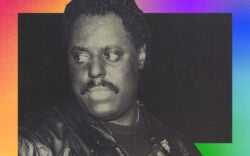Illustration: Robin Lewallen
It’s often said that “music is a conversation”—an endless flow of inspiration and creation.
Within this ever-expanding stream of innovation are many key landmarks that have specifically come from LGBTQ+ artists, groups, and communities. In this article, let’s continue the conversation and explore just a few of many contributions—some of which you may have been previously unfamiliar with.
1. The persistent, driving rhythms of house music
Frankie Knuckles is known as the “The Godfather of House Music.” Enough said, right? He was a multi-hyphenate talent—a DJ kicking off the house music craze, leaving his mark in queer clubs in New York City all the way to his famed residency at the Warehouse in Chicago. He threw parties for all creeds, welcoming dancers of all backgrounds to his wild events. But what specifically did Frankie Knuckles do to shape house music into what it is today?
As disco’s mainstream popularity declined (due in part to the increasing racist and homophobic backlash to radio stations that played them), disco records were relegated to nightclubs, like the ones Knuckles DJ’ed. His open-format style blended disco with electro music, pop music, funk records, and more. Meanwhile, DJs like Jesse Saunders were experimenting with mixing disco records with drum machines and built-in effects on mixers.
Inspired by Saunders and his label Trax Records, Knuckles collaborated with Jamie Principle on “Your Love.” The song, mixing disco drums with the synthesizer warbles of Kraftwerk, soon became a seminal staple in Chicago house sets.
“Your Love”—alongside Jesse Saunders’ “On & On”—was a definitive chapter in Chicago house music. This new sound, bolstered by the very clubs that Knuckles kicked off, established the roots for the sound of house music as we know it today. Whether it’s Daft Punk or David Guetta, Knuckles and the Chicago house music scene cast a long shadow.
2. The melodic and reflective sounds of grunge
Hüsker Dü was a band formed by guitarist and vocalist Bob Mould, drummer and vocalist Grant Hart, and bassist Greg Norton in 1979. The band quickly gained notoriety in Saint Paul’s hardcore punk scene, and by 1983, Hüsker Dü was pushing the limits of hardcore music and venturing into more ambitious and experimental songwriting. Their magnum opus, Zen Arcade, is an indisputably landmark album for alternative music.
Hüsker Dü loved ’60s psychedelic pop groups like The Byrds and The Beatles, and often brought their melodic sensibilities to their own tracks. However, not ones to eschew their hardcore roots, their rhythm guitars boasted the buzzy distortion of MXR M104 pedals, and their leads showcased the distinctive timbres of Ibanez’ stereo chorus pedals. All tied together with Hart’s high-energy drumming and aggressive tempos, Hüsker Dü’s tracks kept the band squarely rooted in the punk rock world.
All of these sonic elements that Hüsker Dü played a role in carving out set the foundation for the grunge sound further developed by the likes of Nirvana, Pearl Jam, and Mudhoney.
3. The metallic timbres of hyperpop
“I start my compositions from a sculptural point,” SOPHIE told V Magazine in 2018. Pulling from the artificial, the manufactured, and the fictile, it’s no wonder SOPHIE always felt beyond human herself. With her unmistakable sound design prowess—building electric zaps using her Elektron Monomachine and crafting unwieldy metallic bolts with her Octatrack—SOPHIE introduced a new perspective on sound design to pop music, not unlike how Wendy Carlos introduced Moog to film scores.
Whether it was the forward-looking “LEMONADE” or the ripped plastic of “Faceshopping,” SOPHIE’s influence spawned a generation of new music makers. From her friend Flume’s flirtations with scratching and dense synths to Charli XCX jettisoning pop music into the experimental to this new generation of hyperpop, SOPHIE’s signature metallic sound design is being blended with every genre under the sun. SOPHIE forever.
Have any of these innovations influenced your own music? Which artists would you like to see us discuss next? Start a conversation with us on the Splice Discord.
August 19, 2022

.svg)
.svg)




